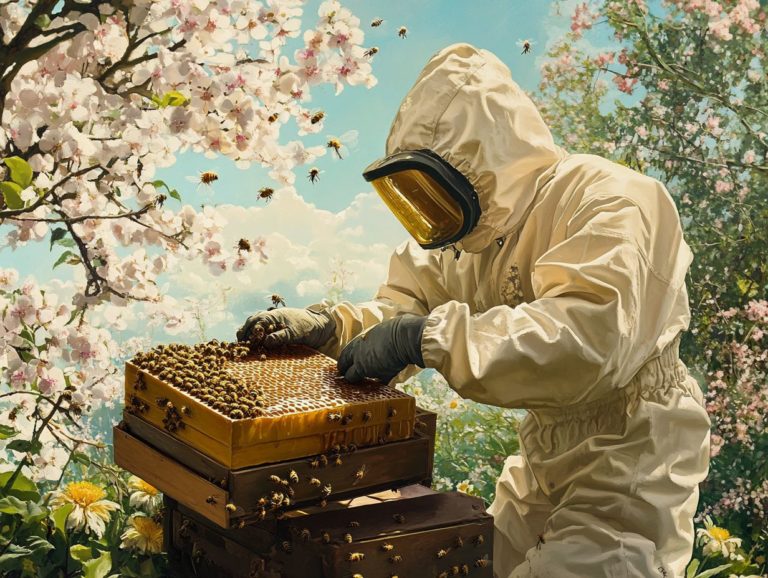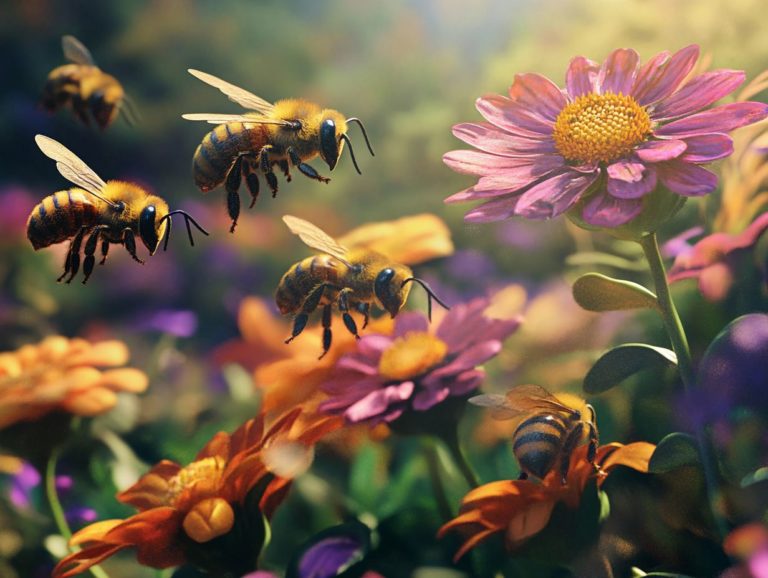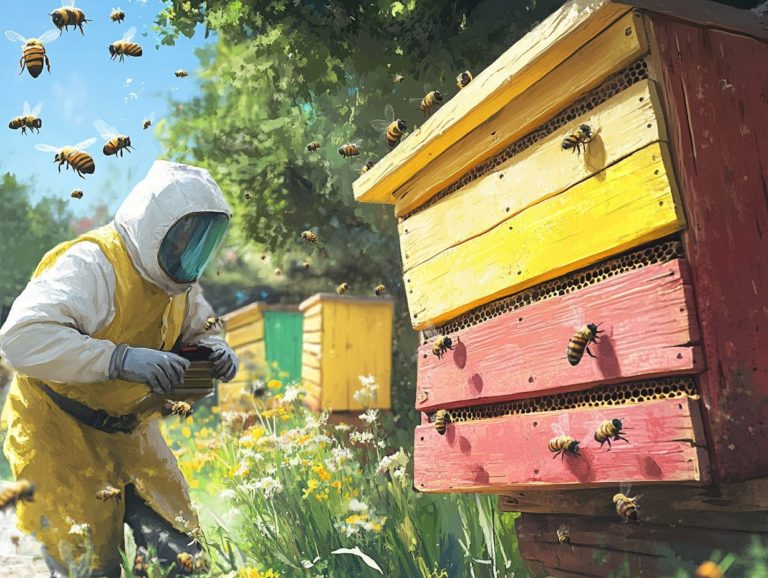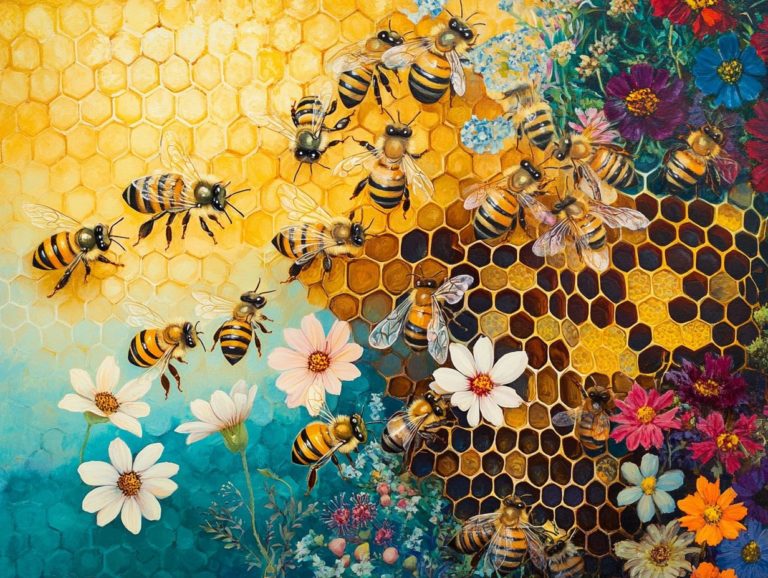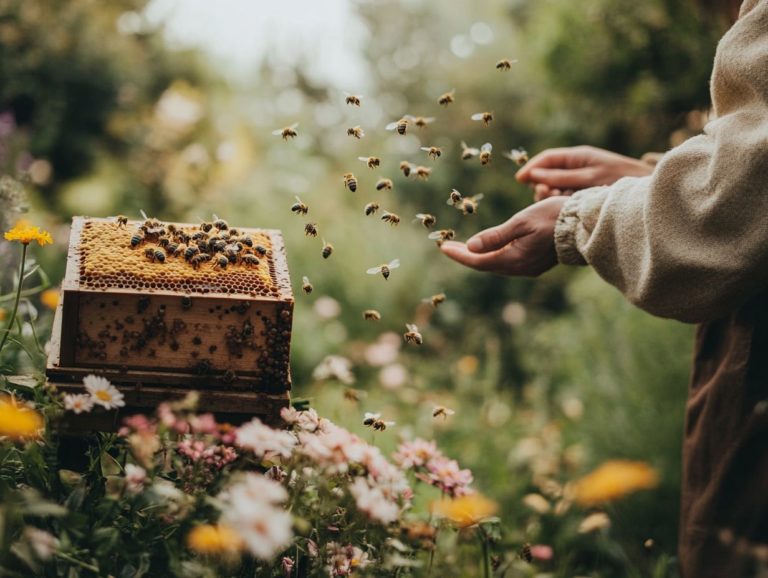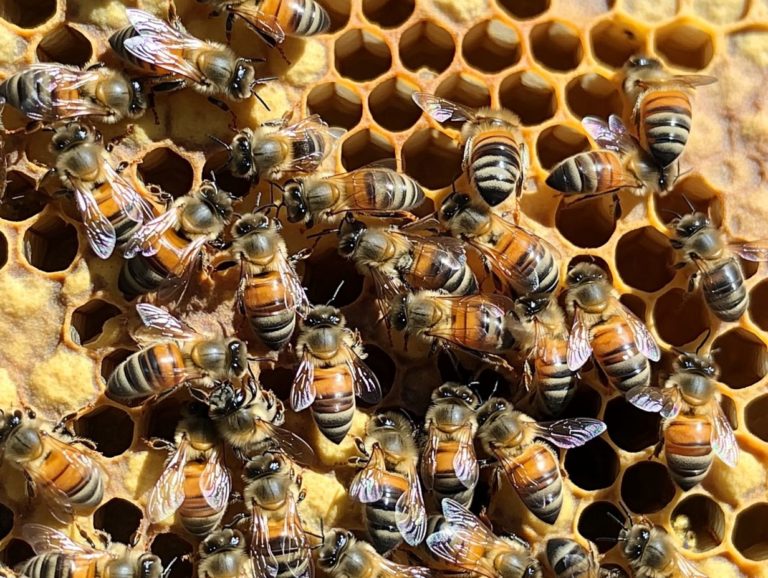Effective Hive Monitoring Techniques
Maintaining a vigilant watch over your bee colony is paramount for nurturing a thriving hive and achieving optimal honey production. This ensures better bee health and contributes positively to pollination and overall agricultural practices.
Get ready to explore a range of hive monitoring techniques that can revolutionize your beekeeping! This article delves into various methods, from straightforward visual inspections to advanced tools that are easy to use. You will gain insights into essential tools such as IoT monitoring and remote monitoring technology that can elevate your monitoring endeavors and discover how to establish a routine that maximizes the health of your apiary.
With the right approach, you will be well-equipped to identify potential issues early on, enhance honey yields, and significantly improve the overall survival of your honey bees. Implementing proper nutrition and winter care can also play crucial roles.
Contents
- Key Takeaways:
- Types of Hive Monitoring
- Tools for Hive Monitoring in Beekeeping
- How to Effectively Monitor Your Hive
- Benefits of Hive Monitoring
- Frequently Asked Questions about Beekeeping and Hive Monitoring
- What are effective hive monitoring techniques for beekeepers?
- Why is hive monitoring important for beekeepers?
- What are some commonly used hive monitoring tools for beekeepers?
- How often should hive monitoring be conducted for optimal results?
- What are some best practices for effective hive monitoring in beekeeping?
- What are the benefits of using technology for hive monitoring in beekeeping?
Key Takeaways:

- Establish a regular hive inspection schedule to stay on top of your hive’s health and catch any issues early on. Consider factors like temperature and humidity during inspections.
- Use a variety of techniques and equipment such as visual inspection, temperature monitoring, and digital scales for a comprehensive understanding of your hive.
- Accurate and detailed record-keeping, coupled with advanced data analysis, can help track changes and identify patterns, leading to better hive management and increased colony survival. This is particularly vital for commercial beekeepers.
Types of Hive Monitoring
In the world of beekeeping, grasping the nuances of hive monitoring is crucial for promoting bee health and maximizing honey production. You ll discover that various monitoring techniques offer invaluable data that can significantly enhance your hive management.
By adopting best management practices and leveraging advanced tools that are easy to use, you can gain deeper insights into colony dynamics, such as the health of your queen bee and the status of brood frames. This approach also enables you to tackle environmental concerns and effectively manage pests like the Varroa mite, a common pest that affects bees.
1. Visual Inspection
Visual inspection serves as a cornerstone technique in beekeeping, enabling you to evaluate the overall health of your hive by closely observing the physical state of the honey bees and their surroundings.
During these inspections, you should remain vigilant for signs of pests, such as Varroa mites, as well as indicators of disease, which may manifest as unusual behavior or the presence of dead bees at the hive entrance. By meticulously checking for these concerning signs, you can glean valuable insights into your hive’s vitality and determine whether immediate action is necessary.
These visual assessments complement other monitoring methods. Utilizing sticky boards and sampling for pathogens provides a holistic view of the colony’s condition. This proactive approach not only facilitates timely interventions but also promotes long-term hive health and productivity.
2. Acoustic Monitoring
Acoustic monitoring allows you to harness sound data to analyze bee activity within the hive, offering invaluable insights into the behavior and health of the colony.
By capturing and dissecting the various sounds produced by the bees, this innovative technology unveils critical changes in hive dynamics, such as the onset of swarming or signs of distress among the worker bees. It leverages the natural acoustic signatures created by the bees during their daily activities, including foraging and communication with one another.
With the application of sophisticated data analytics techniques, you can interpret these sound patterns, leading to a richer understanding of the colony’s well-being. This proactive approach gives you the power to identify potential issues before they escalate, enabling timely interventions and ensuring your hive remains robust and thriving.
3. Temperature Monitoring
Temperature monitoring is an essential aspect of hive management, as maintaining optimal conditions within the hive is critical for the health and well-being of your honey bees.
Without consistent temperatures and humidity levels, your bees may experience stress, which can lead to decreased productivity and even the potential collapse of the colony. For example, if the hive becomes too hot, it can endanger brood development and foster the growth of harmful pathogens. On the other hand, low temperatures can impede bee activity and foraging, disrupting their natural behavior.
To navigate these challenges, beekeepers like you often turn to advanced tools such as digital thermohygrometers and temperature sensors that provide real-time readings. These devices give the power to you to take immediate action in response to fluctuations, ensuring that the microclimate within the hive remains stable. By doing so, you promote healthier, more productive colonies that yield high-quality honey.
4. Hive Weight Monitoring
Weight monitoring serves as an invaluable strategy for you as a beekeeper, allowing you to assess the overall health and productivity of your hives by observing changes in hive weight over time. Monitoring hive bodies for weight can provide insights into honey consumption and sugar syrup feeding patterns.
By employing digital scales, you can detect subtle fluctuations that may indicate variations in honey production levels or potential issues within your colony. For example, a sudden drop in weight could suggest that your bees are consuming their honey stores too quickly or that they might be encountering environmental challenges. On the flip side, a steady increase in weight could signify successful foraging and effective management practices, indicating that your hive is thriving.
By understanding these weight changes, you gain the power to make informed decisions. This could involve optimizing your feeding strategies, enhancing hive ventilation, or preparing for potential swarming events. Ultimately, this proactive approach leads to healthier hives and improved honey yields.
Tools for Hive Monitoring in Beekeeping
Advanced tools for hive monitoring are essential in the realm of modern beekeeping, giving you the power to effectively track and manage the health and productivity of your colonies. Employing data analytics and machine learning can provide deeper insights into health trends and environmental risks.
With the aid of infrared cameras, electronic hive monitors, and audio recording devices, you can gather vital data on bee health, detect pests, and elevate your overall hive management practices. Tools like GatherIQ and SAS can streamline data analysis for better outcomes.
By leveraging the capabilities of remote monitoring technology and sophisticated analytics, you can deepen your understanding of hive dynamics and make informed decisions that truly support the well-being of your bees.
1. Digital Hive Scales

Hive scales are an essential tool for you as a beekeeper, providing precise weight measurements of your hives. This allows for effective tracking of honey production and the overall health of your colonies.
These scales deliver real-time data that captures the weight fluctuations as your bees add or consume honey. This information is invaluable for spotting critical changes that might signal potential issues within the hive. By consistently monitoring the weight, you can make well-informed decisions regarding feeding strategies, hive inspections, and swarm collection measures.
The data you gather can also optimize your harvest times, ensuring you collect honey at its peak quality. Armed with the insights from hive scales, you can elevate your management practices, fostering healthier colonies and boosting productivity over time. Consider integrating flight activity monitoring for added accuracy.
2. Infrared Cameras
Infrared cameras are advanced tools that let you assess temperature variations within your hive. This provides valuable insights into the health and activity of your bees.
By capturing the infrared spectrum, these cameras reveal subtle temperature differences. This can indicate overheating or cooler areas, suggesting overcrowding or distress among your bee population.
With the ability to detect these anomalies without disturbing the hive, you can proactively address potential issues. If you notice an increase in temperature, it might signal that your bees are clustering tightly during hot weather. Cool spots could indicate insufficient insulation or ventilation.
This technology is valued by apiary inspectors and helps you maintain optimal hive conditions. It promotes healthier bee colonies, ensuring your buzzing friends thrive under your care.
3. Audio Recording Devices
Audio recording devices play a vital role in monitoring the sounds bees make to understand their health. They capture sound data that reveals the behavior of your bee colony.
By analyzing these sounds, you gain invaluable insights into the overall well-being of your bees. Variations in buzzing patterns might indicate stress, while a harmonious hum could signal a thriving environment.
This acoustic data can be further analyzed using data analysis for deeper insights. These devices allow you to detect potential issues, such as pests or diseases, before they become visible problems.
This proactive approach elevates your colony management and promotes the longevity of your hives. It ultimately enriches your experience and enhances your output as a beekeeper.
4. Thermal Imaging
Thermal imaging is a remarkable tool that lets you visualize the temperature distribution within your hive. This helps you identify areas of concern and closely monitor bee health.
This technology is particularly useful for identifying queen health and ensuring optimal hive microclimate. By capturing the infrared radiation emitted by surfaces, it enables you to detect subtle temperature changes.
These changes may signal stress or disease within the colony. Its capability to penetrate hive covers without causing disturbance offers a non-invasive method to assess the overall climate of the hive.
This ensures that both your bees and honey reserves are thriving. You can proactively manage conditions like excessive heat or cold spots, which could lead to swarming or compromised brood development.
By leveraging thermal imaging, you pave the way for healthier hives and enhanced productivity.
5. Electronic Hive Monitors
Electronic hive monitors are advanced devices that allow you to oversee hive conditions in real time. This enables remote tracking of bee health and activity.
These innovative tools provide insights into parameters such as temperature, humidity, and brood patterns. This gives you a comprehensive understanding of hive dynamics.
By leveraging data analysis, you can spot trends and potential issues early. This enables proactive management strategies that enhance both productivity and hive health.
The convenience of remote monitoring means you won t need to disturb the hives as frequently. This reduces stress on the bees while maximizing your efficiency in colony management.
Stay ahead of the game with timely alerts that let you respond instantly to any changes. This fosters a more sustainable approach to your beekeeping endeavors.
How to Effectively Monitor Your Hive
Effectively monitoring your hive requires the implementation of best management practices that ensure the health and productivity of your honey bee colonies. Establish a regular monitoring schedule and know precisely what to observe during inspections. Maintaining accurate records is essential for you as a beekeeper.
Employ a variety of monitoring techniques such as visual inspections, temperature monitoring, and advanced remote monitoring technology to gain comprehensive insights into your hives. Seek professional assistance when needed; this can elevate your hive management strategies and enhance your honey production.
1. Establish a Monitoring Schedule
Create a monitoring schedule to manage your hive effectively. This helps you regularly check the health and productivity of your colonies.
A well-structured schedule keeps you in tune with the unique needs of your hives throughout the seasons. Consider factors like temperature fluctuations, flowering patterns, and bee behavior, which can change significantly from spring to fall.
For example, as spring arrives and hive activity surges, increase your checks, focusing on brood development and food reserves. During late summer, shift your monitoring toward preparing for winter, ensuring your bees have adequate supplies.
Consistent observations help you spot potential issues early. This creates a better environment for your bees.
2. Know What to Look For
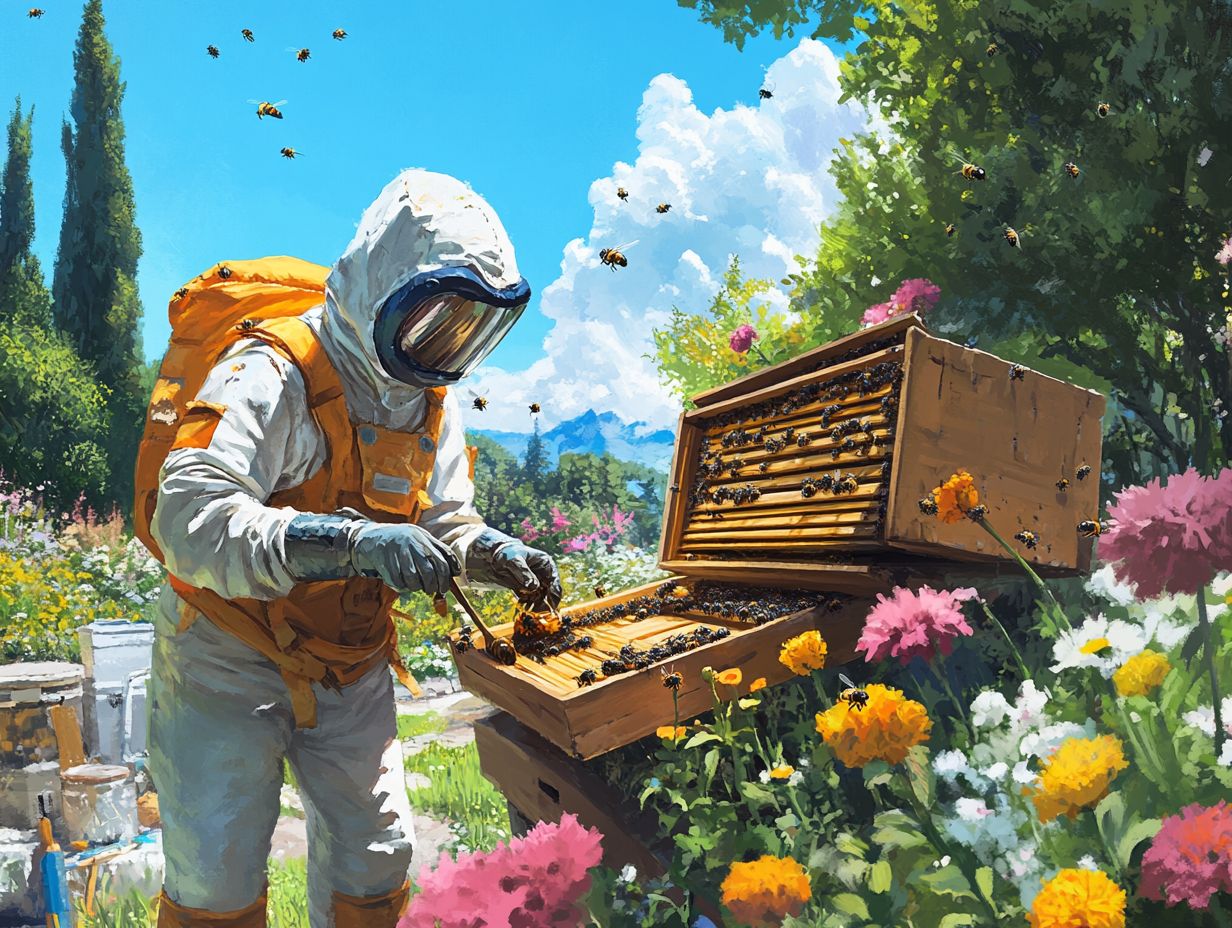
Understanding what to watch for during hive inspections is crucial to identify potential issues that could impact bee health and the productivity of your colony.
Regular checks empower you to ensure that your colonies remain strong and healthy. Don’t miss out on monitoring for pests, especially the notorious Varroa mite, as these parasites can significantly undermine a hive’s vitality. Act quickly to manage pests to protect your hive’s health. Address any signs of disease, such as foul brood or chalk brood, immediately to prevent further spread. You should also evaluate the overall conditions of the hive, including the availability of food resources and the behavior of your bees.
To conduct effective inspections, adopt a systematic approach. Utilize a blend of visual assessments and practical tools, like a hive tool and smoker, for thorough yet calm evaluations of your colony. Consider using IoT monitoring devices for additional insights.
3. Keep Accurate Records
Careful record-keeping of your hive management practices is essential for tracking the health and productivity of your honey bee colonies over time. This documentation aids in identifying patterns in bee behavior and hive dynamics and serves as a critical tool for assessing the effectiveness of various management techniques.
Record the following key data to monitor your hive effectively:
- Hive weight
- Brood patterns
- Health inspections
- Honey yields
- Any interventions made, such as treatments for pests
By regularly analyzing this information, you can make informed decisions that lead to more sustainable practices, optimize honey production, and enhance the vitality of your colonies. Ultimately, leveraging data analysis can uncover valuable insights that help you predict trends, refine your overall hive management, and ensure the longevity of bee populations.
4. Use Multiple Monitoring Techniques
Employing multiple monitoring techniques significantly elevates your hive management, granting you a comprehensive understanding of your colony’s health and activity. This multifaceted approach not only helps you spot potential issues before they escalate but also enables you to tailor your practices to meet the specific needs of your hive.
Visual inspections can uncover pests or disease symptoms, while temperature monitoring ensures that the internal environment remains ideal for your bees. On the other hand, acoustic monitoring can alert you to shifts in the bees’ behavior, such as swarming or distress calls, offering invaluable insights into the dynamics of your colony.
Additionally, integrating sound data and machine learning techniques can further enhance your understanding. By combining these varied methods, you can make informed decisions that align with best management practices, ultimately securing the sustainability and productivity of your hive.
5. Seek Professional Assistance
Seeking professional assistance can truly transform your hive management strategies, especially when you encounter challenges related to bee health and productivity.
Recognizing the signs of environmental stress, disease outbreaks, or pest infestations can feel overwhelming for any apiarist (a person who keeps bees). This is where the expertise of apiary inspectors or entomologists (scientists who study insects) proves invaluable.
These specialists provide insights into better ways to monitor your bees and management practices that are essential for maintaining robust colonies. Collaborating with seasoned beekeepers allows you to tap into a wealth of practical wisdom obtained from years of firsthand experience.
Their shared knowledge can lead to enhanced hive resilience and bountiful harvests, ultimately ensuring that your bees thrive and your apiary flourishes within its local ecosystem.
Benefits of Hive Monitoring
The benefits of hive monitoring are truly extensive, serving as an essential component in maintaining healthy colonies and optimizing honey production. By implementing effective monitoring strategies, you can detect issues early on, enabling timely interventions that greatly enhance both bee health and productivity.
Gaining insights into hive conditions and health trends gives you the power to adopt more informed management practices, ultimately leading to improved colony survival rates and a more sustainable beekeeping approach.
1. Early Detection of Issues
Early detection of issues within your hive is one of the foremost advantages of implementing effective monitoring practices, allowing you to address potential problems swiftly and efficiently.
By utilizing a variety of monitoring tools, such as varroa mite detectors and temperature sensors, you can gain invaluable insights into the health of your colonies. These techniques help you spot early signs of stress or disease, including unusual temperature fluctuations or rising mite populations.
For example, if you notice a sudden spike in mite counts, you must take quick action whether it s applying treatments or requeening to tackle the outbreak before it escalates. This proactive approach not only protects the productivity of your hive but also helps maintain your honey yields.
Regular inspections, enhanced by these monitoring tools, give you the power to keep optimal conditions in your hive, thus contributing to the long-term resilience of your colonies.
2. Improved Honey Production
Improved honey production is a remarkable benefit of effective hive monitoring. This enables you to create the ideal conditions for your colonies.
By employing advanced monitoring techniques, such as temperature and humidity sensors, you gain essential insights into the hive environment. These directly impact bee health and productivity. These insights empower you to make informed management decisions, whether that means adjusting feeding schedules or using better pest control methods.
Regular monitoring allows you to pinpoint stress factors that could hinder honey yields. This prompts proactive interventions that support optimal growth and wax production.
This synergy between monitoring practices and diligent management cultivates a thriving habitat for honey bees. Ultimately, this enhances both the quantity and quality of your honey in your apiary.
3. Better Understanding of Hive Health
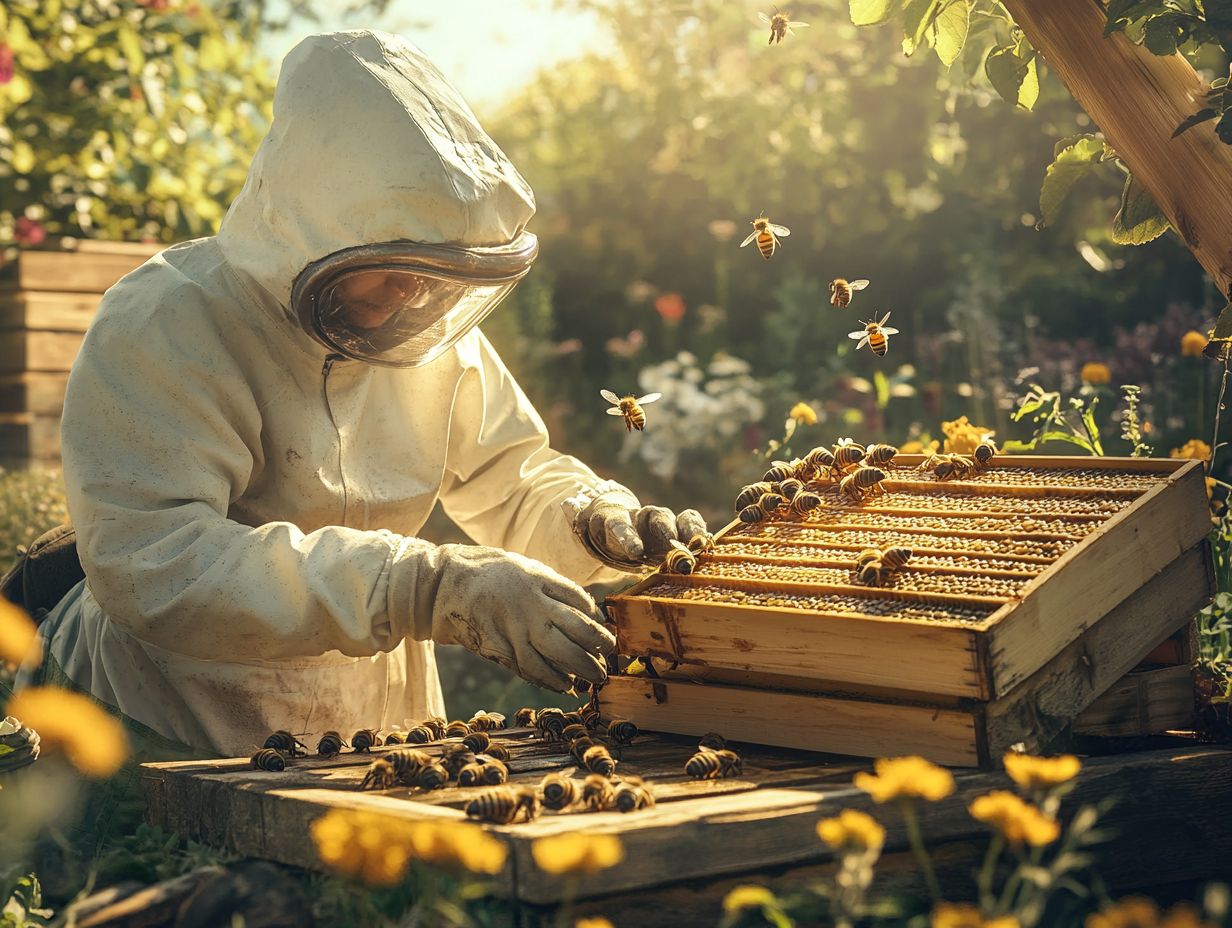
A deeper understanding of hive health comes from consistent monitoring. This enables you to recognize patterns and trends that impact your colonies, including queen health and nutrition.
By employing various monitoring techniques, such as sensor technology and visual inspections, you gather essential data. These provide insights into fluctuations in hive temperature, humidity, and population dynamics.
For example, a spike in temperature might signal pest infestations or insufficient insulation, prompting timely action. Analyzing these data points allows you to anticipate potential issues, ultimately leading to enhanced honey production, improved bee health, and more effective disease management.
This deep dive into hive health enhances care for your hives and boosts overall productivity! It also contributes to a broader understanding of regional trends, including environmental risks and health trends. This allows you to tailor your beekeeping strategies for healthier, more productive colonies.
4. Increased Colony Survival
Increased colony survival rates represent a crucial outcome of your monitoring practices. Timely interventions can effectively mitigate risks and bolster bee health using best management practices.
By employing effective monitoring techniques, such as IoT monitoring (Internet of Things technologies) and acoustic data analysis, you can observe fundamental changes in bee behavior and hive conditions. This is essential for ensuring the well-being of these vital pollinators.
Early detection of potential threats like disease or pest infestations, such as Varroa mite enables prompt action. Best management practices can be tailored to address specific issues that arise.
As a result, implementing these strategies not only fosters healthier colonies but also enhances the overall resilience of bee populations in the face of environmental challenges. Establishing a proactive monitoring system keeps you informed and responsive, ultimately contributing to more sustainable beekeeping practices, including those practiced by commercial beekeepers.
Discover the benefits of incorporating advanced technology and best management practices for improved honey bee health, beekeeping efficiency, and honey production. Start implementing these techniques today to boost your hive’s productivity!
Frequently Asked Questions about Beekeeping and Hive Monitoring
What are effective hive monitoring techniques for beekeepers?
Effective hive monitoring techniques involve regularly checking and recording hive conditions such as population, brood health, food stores, and possible pest and disease infestations. Utilizing modern monitoring tools, like digital scales and hive bodies, helps beekeepers make informed decisions. For example, a beekeeper might identify nutrient deficiency in their hives by monitoring food stores, allowing them to take immediate corrective actions.
Why is hive monitoring important for beekeepers?
Hive monitoring is important because it allows beekeepers to proactively address potential problems and maintain hive health. Regular monitoring can also help prevent hive losses and improve honey production, which is crucial for pollination and agricultural practices. For instance, timely monitoring might help a beekeeper detect a drop in bee population before it escalates into a larger issue.
What are some commonly used hive monitoring tools for beekeepers?
Common hive monitoring tools include hive scales and temperature sensors. Humidity sensors, entrance reducers, and inspection trays are also popular.
How often should hive monitoring be conducted for optimal results?
For the best results, monitor your hives at least once a month. During the busy beekeeping season, aim for every 1-2 weeks to keep your bees thriving!
During times of potential stress, such as a nectar dearth, severe weather, or high pest activity, more frequent monitoring may be necessary.
What are some best practices for effective hive monitoring in beekeeping?
Some best practices for effective hive monitoring include recording observations and data. Use multiple tools for a more comprehensive view, and compare current data to previous records to track changes over time.
Using tools that analyze data can help you understand hive health better. It is also important to handle and disturb the hive as little as possible during monitoring to reduce stress on the bees.
What are the benefits of using technology for hive monitoring in beekeeping?
Technology, such as hive monitors and data analysis software, can provide real-time data and analytics, making hive monitoring more efficient and accurate. It also allows beekeepers to remotely monitor their hives, reducing the need for frequent physical inspections and disturbances to the bees.
Technology also helps with winter care and tracking honey consumption and bee activity.

